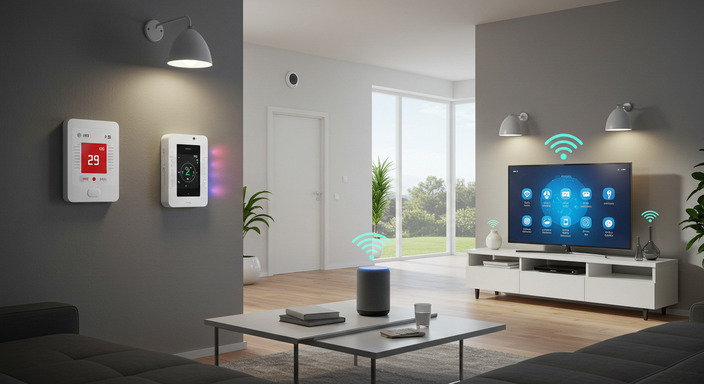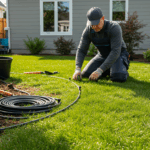Introduction to Smart Home Devices
Imagine a world where your home anticipates your needs even before you do, a world where the mundane chores of everyday life are automated to give you more freedom and peace of mind. This is not a distant future; it is now possible with smart home devices. According to recent statistics, it is estimated that the global smart home market will reach around $158 billion by 2024, illustrating their growing importance in modern life. But what exactly are these devices, and how do they transform our homes?
Smart home devices are gadgets equipped with internet connectivity that enable them to be controlled remotely. They work together to automate various household tasks, ensuring efficiency, comfort, and safety. This article will explore different categories of smart home devices, discuss their benefits and challenges, and provide insightful advice on building your smart home ecosystem.
Types of Smart Home Devices
Smart home devices are incredibly versatile and cater to various aspects of household management. Here, we delve into some core categories that shape the foundation of a smart home.
| Category | Functionality | Examples |
|---|---|---|
| Lighting | Automated control of lighting based on schedule or ambient conditions | Philips Hue, LIFX bulbs |
| Security | Enhanced security features including remote monitoring and alerts | Ring doorbell, Nest Cam |
| Climate Control | Automated temperature adjustment for energy efficiency | Nest Thermostat, Ecobee |
| Entertainment | Integration and voice-controlled entertainment systems | Amazon Echo, Google Home |
| Appliances | Connected kitchen and household appliances for convenience | Samsung Smart Fridge, iRobot Roomba |
| Health and Wellness | Monitoring of health metrics and promotion of well-being | Withings Sleep Analyzer, Fitbit |
Each category serves a distinct purpose, allowing homeowners to target specific needs. These devices provide more than mere convenience; they enhance the overall functionality and security of modern homes.
Benefits of Implementing Smart Home Devices
The adoption of smart home technology offers myriad benefits that go beyond mere convenience. Firstly, these devices contribute significantly to energy efficiency, leading to reduced utility bills. For instance, smart thermostats learn your schedule and adjust heating or cooling when necessary, optimizing energy usage. Additionally, smart lighting systems can automatically turn off the lights when a room is empty, further reducing unnecessary electricity consumption.
Security is another crucial benefit of smart home devices. They offer peace of mind by allowing homeowners to monitor their properties from anywhere in the world. Advanced security systems can notify users of unusual activities, such as a door being opened unexpectedly, or detect smoke and carbon monoxide, ensuring prompt emergency response.
Lastly, smart home devices enhance the quality of life by creating a seamless and adaptable living environment. With voice-activated assistants, one can control multiple gadgets, streamlining daily tasks and providing a more relaxing and efficient home experience.
“The aim of smart home technology is to provide the maximum amount of convenience, underlined by efficiency and security, in a seamless manner.” – Tech Analyst
Challenges in Adopting Smart Home Technology
Despite their numerous advantages, smart home devices pose certain challenges. A primary concern is the integration and compatibility of devices from different manufacturers. Many smart home gadgets operate on proprietary systems, complicating their seamless integration into a single smart home network.
Another challenge is data privacy and security. As these devices are connected to the internet, they are vulnerable to hacking and data breaches. Manufacturers are continuously working to enhance security protocols to protect user data. However, the constant evolution of cyber threats necessitates continuous vigilance from both manufacturers and users.
Furthermore, the initial cost of transitioning to a smart home setup can be high, as each smart device usually represents a significant investment. This cost can be a barrier for budget-conscious consumers, even though long-term savings, particularly in energy consumption, can offset these initial expenses.
Creating a Smart Home Ecosystem
Building a smart home ecosystem requires thoughtful consideration of your specific needs and how various devices can fulfill them. Here is a simple guide to help you begin:
1- Identify your needs and priorities by assessing what aspects of your home life would benefit the most from automation.
2- Research compatible devices to ensure they work seamlessly together within the same smart home ecosystem.
3- Start small with essential devices like smart speakers or plugs, which are typically easy to set up and use.
4- Gradually expand your system by adding more complex devices such as smart thermostats or home security systems as you become more comfortable with the technology.
Keeping these steps in mind will facilitate a more streamlined and economical deployment of your smart home setup.
Interoperability and Compatibility
One of the crucial aspects to consider in the construction of a smart home is the interoperability and compatibility of devices. Many smart home gadgets come with their dedicated apps and platforms, leading to fragmentation. To avoid this pitfall, users should focus on products that use open standards and protocols like Zigbee, Z-Wave, or Thread, which allow for better integration.
Many consumers opt for ecosystems sponsored by major companies like Amazon Alexa, Google Assistant, or Apple HomeKit, which allow multiple devices to operate cohesively. Choosing devices that support multiple platforms can future-proof your investment, ensuring compatibility with future technology developments.
Environmental Impact of Smart Homes
Smart homes have the potential to reduce our ecological footprint significantly. By intelligently managing energy consumption, smart homes contribute to a more sustainable lifestyle. Smart meters and home energy management systems provide insights into energy usage patterns, encouraging more efficient behaviors. Devices such as smart showers or irrigation systems also help conserve water by adapting to real-time needs or adjusting to weather conditions.
Integrating renewable energy sources like solar panels with smart home systems can further amplify sustainability efforts. Smart inverters ensure that the energy generated is used optimally, reducing dependence on non-renewable energy sources.
The Future of Smart Home Devices
As technology advances, the scope and functionality of smart home devices will continue to expand. Artificial intelligence (AI) and machine learning will play pivotal roles in the future of smart homes, further enhancing customization and prediction capabilities. AI will enable devices to learn users’ habits and preferences, creating personalized living experiences that evolve with the user.
Voice recognition and natural language processing technologies are expected to enhance how we interact with our devices, making them more intuitive and user-friendly. Additionally, the growing adoption of 5G technology will facilitate the faster transfer of data, enabling more responsive and efficient smart home ecosystems.
The path forward is clear: smart homes will become even more integral to our daily lives, emphasizing efficiency, safety, and sustainability.
FAQ – Common Questions
What is a smart home device?
A smart home device is a gadget with internet connectivity that allows remote control, providing automation, efficiency, and security to household operations.
Do I need a smart home hub?
While a hub can centralize the control and integration of various devices, many smart home gadgets can operate independently with apps or voice assistants.
Are smart home devices secure?
Manufacturers are improving security frameworks to safeguard against breaches, but users should also activate security features and update software regularly.
Can smart home devices save money?
Yes, many devices reduce energy consumption and utility costs, such as smart thermostats and lighting systems, balancing the initial investment over time.
What should I consider when buying smart home devices?
Consider compatibility, connectivity, cost, and specific needs, such as security, energy management, or convenience, when selecting smart home devices.
How do I control smart home devices?
Devices can usually be controlled via dedicated apps, voice commands using smart speakers, or centralized hubs, based on the devices’ ecosystem compatibility.
Conclusion
Smart home devices are revolutionizing how we interact with our living spaces, offering enhanced convenience, safety, and energy efficiency. Whether through automating lighting, securing property, or optimizing energy use, the influence of smart home technology is profound. Despite challenges like integration and privacy concerns, the benefits far outweigh these hurdles for many users. As technology advances, smart homes will become even more sophisticated, potentially transforming every facet of daily living. By understanding and considering the various aspects discussed, consumers can make informed decisions to better enhance their home environments with smart technology.
Meta Descrição: Explore the world of smart home devices: benefits, challenges, and the future, plus tips for building your smart home ecosystem.







